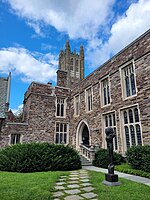Witherspoon Street School for Colored Children
Brick buildings and structuresBuildings and structures in Princeton, New JerseyColonial Revival architecture in New JerseyNational Register of Historic Places in Mercer County, New JerseyNew Jersey Register of Historic Places ... and 3 more
Public elementary schools in New JerseySchools in Princeton, New JerseyUse mdy dates from August 2023

The Witherspoon Street School for Colored Children educated the African-American children of Princeton, New Jersey from 1858 until the Princeton Public Schools were integrated in 1948. The school was originally located at the building still standing at 184 Witherspoon Street. As enrollment increased it moved, in 1909, to 35 Quarry Street. The Quarry Street building was expanded in 1939 and again in 1966, giving it its present appearance. The former school has since been turned into an apartment building. It was added to the National Register of Historic Places on March 9, 2005, for its significance in education.
Excerpt from the Wikipedia article Witherspoon Street School for Colored Children (License: CC BY-SA 3.0, Authors, Images).Witherspoon Street School for Colored Children
Quarry Street,
Geographical coordinates (GPS) Address Nearby Places Show on map
Geographical coordinates (GPS)
| Latitude | Longitude |
|---|---|
| N 40.353138888889 ° | E -74.662944444444 ° |
Address
Quarry Street 35
08542
New Jersey, United States
Open on Google Maps









